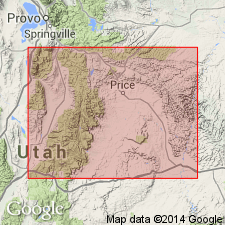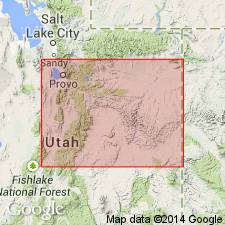
- Usage in publication:
-
- Allen Valley shale*
- Modifications:
-
- Original reference
- Dominant lithology:
-
- Shale
- Bentonite
- Siltstone
- Sandstone
- Limestone
- AAPG geologic province:
-
- Wasatch uplift
Summary:
Pg. 122, 127-128, 133 (fig. 17). Allen Valley shale of Indianola group. Body of marine shale, 600 to 800 feet thick, underlying Funk Valley formation (new) and overlying Sanpete formation (new) [both of Indianola]. Consists largely of evenly bedded gray marine shale interbedded with thin layers of yellowish bentonite, siltstone, very fine grained sandstone, and gray limestone. No individual bed more than 1 foot thick. Thickness at type locality 620 feet. [Fossils of middle Colorado (Carlile) age; correlates with Ferron sandstone member of Mancos shale.] Age is Late Cretaceous.
Type locality: at base of Wasatch Plateau in Allen Valley, about 3 mi southwest of Manti, Sanpete Co., central UT. Top and base are well exposed in Salina Canyon, about 5 mi east of Salina.
Source: US geologic names lexicon (USGS Bull. 1200, p. 57-58); supplemental information from GNU records (USGS DDS-6; Denver GNULEX).

- Usage in publication:
-
- Allen Valley Shale*
- Modifications:
-
- Age modified
- AAPG geologic province:
-
- Wasatch uplift
Summary:
Is of middle Turonian age. Palynomorphs identified in NW1/4 sec 11, T10S, R4E, Utah Co, UT on the Wasatch uplift.
Source: GNU records (USGS DDS-6; Denver GNULEX).
For more information, please contact Nancy Stamm, Geologic Names Committee Secretary.
Asterisk (*) indicates published by U.S. Geological Survey authors.
"No current usage" (†) implies that a name has been abandoned or has fallen into disuse. Former usage and, if known, replacement name given in parentheses ( ).
Slash (/) indicates name conflicts with nomenclatural guidelines (CSN, 1933; ACSN, 1961, 1970; NACSN, 1983, 2005, 2021). May be explained within brackets ([ ]).

